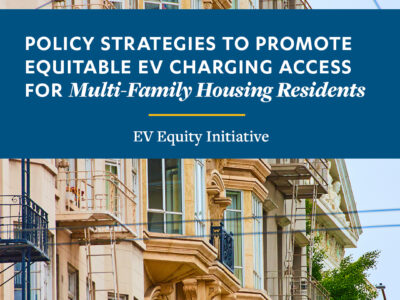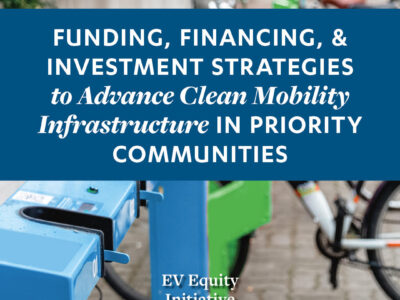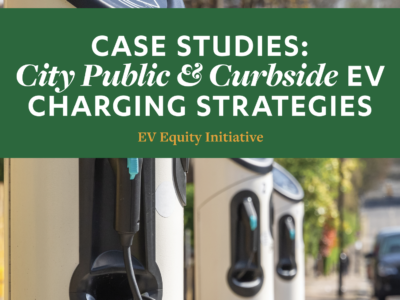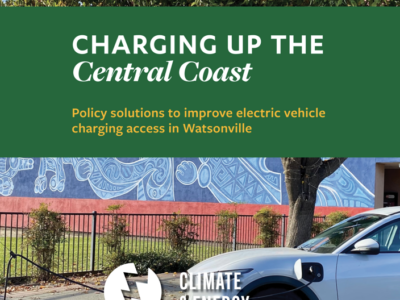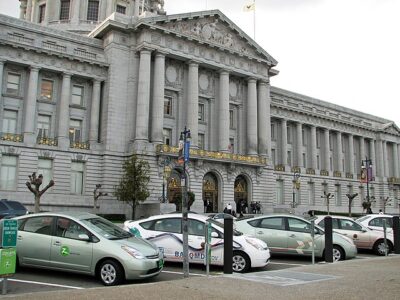electric vehicle charging
A Data-Driven Case for Level 1 EV Charging in Multifamily Housing–and its Equity Implications
New data insights from a community choice aggregator elevate the role of Level 1 charging in an equitable (and rapid) EV transition
Discussions about Level 1 (L1) and Level 2 (L2) electric vehicle charging generally posit a simple tradeoff: L2 (which requires a dedicated high-capacity electrical hookup) offers greater speed and convenience, while L1 (which can run on a standard 120V outlet) offers broader scale and affordability. L1’s benefits find particular traction in residential charging spaces–where drivers …
CONTINUE READINGEV Charging Access for Multifamily Housing Residents
New CLEE report highlights key findings for equity-oriented program design
The rapidly approaching electric vehicle (EV) transition that California and a dozen other states have committed to enact over the coming decade mounts pressure on state and local governments to deliver millions of new EV chargers across various location types. Homes constitute the core of a convenient and reliable charging network, and EV charging infrastructure …
Continue reading “EV Charging Access for Multifamily Housing Residents”
CONTINUE READINGFinancing and Investment Strategies for an Equitable Clean Mobility Transition
New CLEE / Prospect Silicon Valley report outlines top strategies from a series of expert convenings
The transition to 100 percent zero-emission vehicle (ZEV) sales by 2035 will require massive investment in electric vehicle charging infrastructure throughout California and in other states that have adopted the same phaseout targets. A variety of structural barriers to charging access make California’s priority populations particularly reliant on public charging infrastructure to meet their ZEV …
Continue reading “Financing and Investment Strategies for an Equitable Clean Mobility Transition”
CONTINUE READINGHow Can Cities Deliver Equitable EV Charging to the Curbside and Public Right of Way?
New CLEE Report Presents Case Studies and Elevates Key Strategies
As California and other states transition to one hundred percent zero-emission new vehicle (ZEV) sales by 2035, local governments will play a crucial role in addressing inequities in the ZEV transition. Limited access to abundant and reliable charging equipment remains a key barrier to ZEV adoption for all, and city governments can lead efforts to …
CONTINUE READINGHow Can Cities Ensure EV Charging Accessibility for Lower-Income Drivers?
Watsonville, California as a Case Study for Policymakers
California’s ambitious goal to end the sale of internal combustion engine passenger vehicles by 2035 will require addressing the challenges faced by lower- and moderate-income drivers in accessing battery-powered electric vehicles (EVs). Chief among these concerns is their need to have a convenient and affordable place to charge the vehicles. Currently these residents too often …
Continue reading “How Can Cities Ensure EV Charging Accessibility for Lower-Income Drivers?”
CONTINUE READINGHow are California Cities Planning for the EV Transition?
Some leaders are emerging, but plenty of room for more equity-centered programs
With California’s 2035 zero-emissions vehicle transition target now just over a decade away, state and local leaders face an urgent need to ensure that sufficient electric vehicle charging infrastructure is available to meet the needs of all drivers. Electrified vehicles constituted nearly a quarter of all new sales in 2023, but publicly accessible chargers still …
Continue reading “How are California Cities Planning for the EV Transition?”
CONTINUE READINGAre California Cities Ready for an Equitable EV Transition?
How well are cities planning for the transition, and how can we track readiness?
A recent report from ACEEE reinforces California’s leadership in vehicle electrification–at the state level, California’s EV policies, incentives, and supporting strategies outpace the closest competitors by a significant margin (and most pro-electrification states’ programs owe their design and federal authorization to California): Source: ACEEE, 2023 Transportation Electrification Scorecard. But with …
Continue reading “Are California Cities Ready for an Equitable EV Transition?”
CONTINUE READINGMapping City Priorities for an Equitable EV Infrastructure Rollout
How can cities identify high-priority, high-feasibility, high-utility sites?
As state regulators and auto manufacturers begin the drive toward 100 percent zero-emission vehicle sales by 2035, leaders across California face a daunting challenge. How can they ensure that all Californians–not just those who can afford a new EV and a charger in their garage–have access to affordable, reliable, and convenient vehicle charging that meets …
Continue reading “Mapping City Priorities for an Equitable EV Infrastructure Rollout”
CONTINUE READINGHow Can Local Governments Plan for Equity in EV Infrastructure?
In August, the California Air Resources Board finalized regulations that will phase out the sale of new internal combustion engine automobiles by 2035. The regulations (known as Advanced Clean Cars II) deliver on a commitment Governor Newsom made in a 2020 executive order and build on decades of emissions reduction programs from CARB. In turn, …
Continue reading “How Can Local Governments Plan for Equity in EV Infrastructure?”
CONTINUE READINGMaking Electric Vehicles More Accessible for Lower-Income Californians
New policy report on solutions to improve equity in EV deployment | Webinar May 24
Join us for a webinar to discuss the report findings and EV equity solutions with state, local, and industry leaders on Tuesday, May 24 at 1pm PT. RSVP here. Today, the Center for Law, Energy and the Environment (CLEE) at Berkeley Law and the Emmett Institute on Climate Change and the Environment at UCLA Law …
Continue reading “Making Electric Vehicles More Accessible for Lower-Income Californians”
CONTINUE READING



